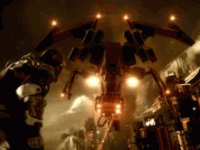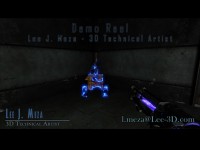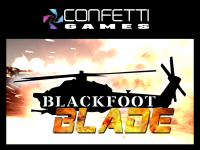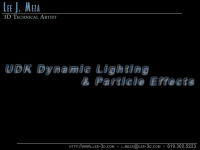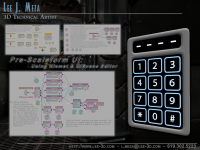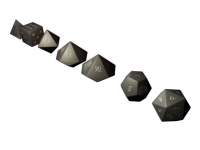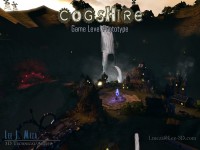Credits Reel
Just a short compilation that shows a few highlights from the titles i have been credited on thus far in my career. This reel is basically a snapshot of my career as of the start of 2014.
Demo Reel
I wanted to be a part of the game industry for as long as I can remember. I originally started pursuing this dream as a Computer Science student hoping to become a programmer. At some point though, I realized that to fully realize my potential I needed an outlet for my creative passion as well. This led me to change my major to Game Art & Design. I have now found the niche that my unique blend of logic and creativity fills in the field of Technical Art.
I have six years of academic experience; two in computer science and four in game art and design. I am proficient with several 3D modeling applications including Maya, 3DS Max, and Zbrush. I am versed in the Unreal Tournament 3 engine both in it’s initial UT3 Editor form and it’s expanded form UDK. I am familiar with several scripting and programming languages including MEL, javascript, Uscript, Lua, Visual Basic, C++, and Java. I am currently learning Python in my free time in order to further expand my repertoire. I have worked as a tech artist on AAA title Uncharted 3, I have been the lead technical artist at two small game studios, and I have done special effects for a short film that won “Best Short” at Screamfest LA 2012.
This is a demo reel to show a brief yet varied selection of my skills. I hope it entertains, inspires, and impresses. Thank you for watching.
Lead Technical Artist
I was the lead technical artist at Confetti Games through the development of their studio-launch title Blackfoot Blade. Here is the first trailer made for the game in it’s beta stage. Duties included creating and maintaining particle effects, integrating art assets, developing pipeline tools for art team (using MEL scripting, XML data files, and C++), working closely with programmers to develop and streamline our art pipeline to get assets into the game quickly and efficiently. Acted as liaison to contract artists and implemented the contracted assets into our pipeline.
UDK Dynamic Lighting and Particle Effects
These are a sampling of effects achieved through use of particle effects and scripted lighting in UDK. The particle effects are set up in Unreal’s Cascade editor. The lighting effects are a combination of material based light functions and Kismet scripting.
Effect one is a sci-fi plasma generator. The lighting is controlled through Kismet to flicker at randomized intervals that are generated on the fly through Kismet and then piped into the playback speed of a matinee event that toggles the dynamic light off and on. The beams/arcs are set up in Cascade as beam emitters. The crackling arc itself is achieved by panning cloud textures across one another in a dynamic material that is then applied to the beam particles.
The second effect is a fire effect consisting of 3 particle emitters and a material based light function. The emitters include one blobby particle emitter that creates the main flames of the fire effect, one smoke emitter, and a randomized spark emitter that emits bursts of sparks at randmized intervals to simulate the popping and cracling that occurs as wood and other fuel are combusted.
Finally there is the damaged light effect which consists of a spark emitter, a scripted material instance, and a scripted dynamic light. The material instance is controlled by the same script that toggles the light off and on; when it toggles the light off it also turns off the emissive channel of the material instance and when the light is toggled back on the emissive channel of the material is also reactivated. The sparks are a very basic burst emitter in Cascade which has its burst fired at random intervals.
Kismet: Pre-Scaleform Keypad (Unreal UIScene)
I needed a keypad for a project and had no idea how to implement one in the UT3 Engine so I decided to attempt to teach myself the UIScene Editor. I had no experience with the editor and documentation on it was virtually nonexistent at the time I was working on this project so after much trial and error, I devised a layered UIScene interface and several kismet sequences to accomplish my goal. The setup is not ideal and is not as clean and elegant as it would be with today’s Scaleform GFx UI’s, but it got the job done and it serves as another example of my ability to problem solve and pick up unfamiliar systems.
C++ Games
These are some quick games I wrote in C++ while trying to learn the language. I have not worked extensively in C++ having learned it on my own, but I am very comfortable learning new languages and am always trying to expand my knowledge. If you would like to try the two small games I’ve written the links are provided below:
MEL: D&D Dice Roller
This was a project I undertook during my time at The Art Institute of California – San Diego. It is featured in my main demo reel. The assignment I was given was to write a MEL process that would accept variables and give different output based on the data provided to the process. I decided I wanted to go beyond the basic requirements and asked the instructor if that would be OK; he agreed. The dice roller was born out of my desire to challenge myself and to stretch the definition of what MEL can do. I didn’t want to write another procedure to duplicate a piece of geometry and apply arbitrary transformations to it, I wanted to do something that would force me to think outside of the box; the dice roller idea was born.
I created a dice roller application that builds on the Maya physics engine to roll the dice. Rather that just make a random number generator that tells the die which face will point vertical after the roll, I decided to use three random values per die and assign them to the three spin variables for X, Y, and Z as well as a fourth random value that would be assigned to the initial velocity of the die, thus achieving a more natural die roll. I also wanted the user to be able to select which type of die to roll and how many, allowing the alternative dice used in Dungeons and Dragons rather than just a standard six sided die.
Cogshire: UnrealScript
On this project I was thrown into an unfamiliar scripting language with which I had never previously worked. I had to implement a custom weapon into our prototype which did not conform to any of those supplied by the engine. Over the course of 3 weeks I taught myself the rudiments of UnrealScript and implemented our custom weapon into our prototype by drawing from the exiting weapon classes and modifying the code to fit our game.
More to be Added Soon!
I will be updating and adding more examples as time allows.

